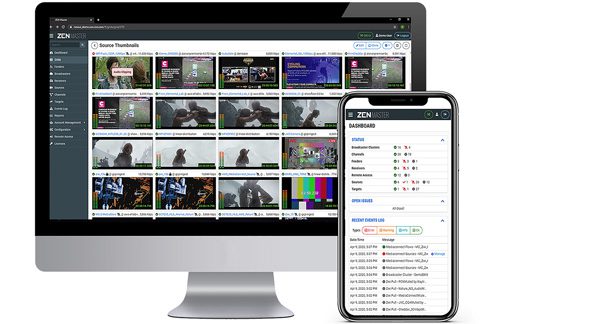Zixi Helps Broadcasters and OTT Service Providers Meet the Demands of Audiences Looking for 4K and HDR Content Across 5G Enabled Devices
A recent AWS Blog Post highlights the efforts between Zixi, AWS and Verizon to test contribution and distribution over 5G networks. To read the original post, click here.
Zixi is currently piloting delivery over Verizon 5G networks using AWS Wavelength technology to deliver UHD media workflows and 5G-enabled production at scale. Zixi, an AWS partner, is working with a major global broadcaster to test live and live linear 4K and 8K broadcast media workflows for 5G distribution. Other Zixi customers are experimenting with consumer-facing immersive experiences delivered via AWS Wavelength Zones at the edge of Verizon’s 5G network.
“Today the business of live events is cumbersome, infrastructure intensive, and high cost. What we’re doing with Verizon 5G and AWS Wavelength Zones is streamlining that process,” said Gordon Brooks, Executive Chairman and CEO for Zixi. “We’re changing the economics; we’re changing how you go about doing it and how you go about experiencing it.”
Customers use Zixi’s technology with the AWS Elemental Media Services including AWS Elemental MediaConnect, a high-quality transport service for live video. Now, to help content providers deliver new kinds of live streamed sports and entertainment experiences, Zixi uses AWS Wavelength to power its Software Defined Video Platform (SDVP). The SDVP leverages ultra-low latency access to AWS compute and storage services enabled by AWS Wavelength at the Verizon 5G Edge to process huge amounts of UHD video and compress it for delivery to mobile devices.
“With AWS and Verizon we’ve had a lot of success in showing how the workflows could be configured to take advantage of the robust, low-latency aspects of 5G. But you first need access to it and that’s where the Verizon 5G network and AWS Wavelength cloud computing at the edge come in. Wavelength allows us to move video processing to the edge and to deliver additional performance at every part of the content delivery chain,” said Eric Bolten, VP of Business Development for Zixi.
The SDVP leverages AWS Wavelength’s ability to support a wide variety of remote and distributed production scenarios. The combination of the SDVP and AWS Wavelength allow customers increase production workflow efficiency. They in turn can innovate faster and offer new services, as well as a higher quality of experience to their subscribers for an increasingly wide range of 5G capable devices.
“In order to scale, to go from hundreds of streams to tens of thousands of streams and clients, you need the ability to have views across the organization, between organizations, and easily manage both,” said Bolton. “5G better optimizes overhead, so you can maximize traffic spectrum and reduce latency. Now with Wavelength available at the 5G network edge, this combined mobile edge compute (MEC) solution foretells the future of mobile broadcast workflows.”

5G advancements allow mobile edge computing for broadcast and OTT contribution and delivery to the consumer. “It has very high potential for disruption in a number of ways for organizations who are acquiring or distributing a signal,” Bolton said, adding that ongoing field testing shows promising results, with latency below 10 ms over an 80–100 MBps pipe.
“The technology makes virtual control rooms possible, where a production team can order 10 or 20 camera sets and have curated subsets that are available to the general public,” Bolten said. “That’s when sponsorship and customization begin to support real business models. There’s no question that MEC is the future of live production and contribution. We are migrating what we have already been doing with AWS using Amazon S3, and now making a connection to Wavelength Zones at the edge of 5G networks. These kinds of gateways on the 5G network open up everything.”
The industry is still learning the benefits, as well as the challenges, of putting linear video across a MEC solution. The results have been promising as the Zixi team looks to streamline the process for using termination devices, like 4K 200 MBps decoders, and Wi-Fi networks in a hybrid infrastructure for video file delivery.
“We’re working to understand the behavior of a 5G network in real world conditions,” Bolten said. “Zixi leverages the 5G network to provide high quality of service for customers who have applications requiring ultra-low latencies. Customers can now build latency-sensitive applications with AWS Wavelength and Verizon’s 5G Ultra Wideband network. The goal for us—AWS, Verizon, and Zixi—is to address the three main elements of live streaming success: latency, overhead, and uptime. The industry is now ready to go. The industry has evolved from science experiments to real world production deployments today, not next year.”


